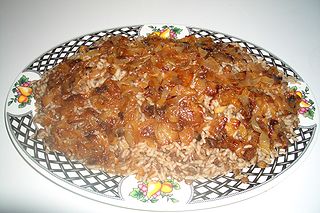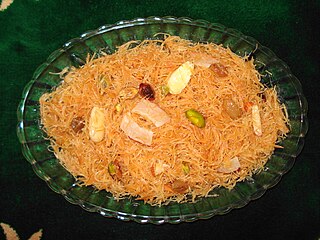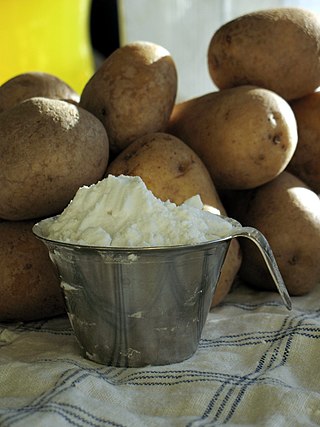
Pasta is a type of food typically made from an unleavened dough of wheat flour mixed with water or eggs, and formed into sheets or other shapes, then cooked by boiling or baking. Pasta was originally only made with durum, although the definition has been expanded to include alternatives for a gluten-free diet, such as rice flour, or legumes such as beans or lentils. Pasta is believed to have developed independently in Italy and is a staple food of Italian cuisine, with evidence of Etruscans making pasta as early as 400 BCE in Italy.

Flour is a powder made by grinding raw grains, roots, beans, nuts, or seeds. Flours are used to make many different foods. Cereal flour, particularly wheat flour, is the main ingredient of bread, which is a staple food for many cultures. Corn flour has been important in Mesoamerican cuisine since ancient times and remains a staple in the Americas. Rye flour is a constituent of bread in both Central Europe and Northern Europe.

Dough is a thick, malleable, sometimes elastic paste made from grains or from leguminous or chestnut crops. Dough is typically made by mixing flour with a small amount of water or other liquid and sometimes includes yeast or other leavening agents, as well as ingredients such as fats or flavourings.

Polish cuisine is a style of food preparation originating in and widely popular in Poland. Due to Poland's history, Polish cuisine has evolved over the centuries to be very eclectic, and shares many similarities with other national cuisines. Polish cooking in other cultures is often referred to as à la polonaise.

Mashed potato or mashed potatoes, colloquially known as mash, is a dish made by mashing boiled or steamed potatoes, usually with added milk, butter, salt and pepper. It is generally served as a side dish to meat or vegetables. Roughly mashed potatoes are sometimes called smashed potatoes. Dehydrated instant mashed potatoes and frozen mashed potatoes are available. Mashed potatoes are an ingredient in other dishes, such as dumplings and gnocchi.

Chinese noodles vary widely according to the region of production, ingredients, shape or width, and manner of preparation. Noodles were invented in China, and are an essential ingredient and staple in Chinese cuisine. They are an important part of most regional cuisines within China, and other countries with sizable overseas Chinese populations.

A potato masher, tater masher, bean masher, pea masher, masher, or crusher is a food preparation utensil used to crush soft food for such dishes as mashed potatoes, apple sauce, or refried beans. Potatoes mashed using a potato masher tend to be fluffier and lighter in texture compared to other methods of mashing, because use of the device reduces cell damage to the potato, releasing less starch.

A latke is a type of potato pancake or fritter in Ashkenazi Jewish cuisine that is traditionally prepared to celebrate Hanukkah.

Ukrainian cuisine is the collection of the various cooking traditions of the people of Ukraine, one of the largest and most populous European countries. It is heavily influenced by the rich dark soil from which its ingredients come, and often involves many components. Traditional Ukrainian dishes often experience a complex heating process – "at first they are fried or boiled, and then stewed or baked. This is the most distinctive feature of Ukrainian cuisine".

Ricing is a cooking term meaning to pass food through a food mill or "ricer", which comes in several forms. In the most basic, food is pushed or pressured through a metal or plastic plate with many small holes, producing a smoother result than mashing, but coarser than pureeing or passing through a sieve or tamis. The size of the product produced by ricing is about the same as grains of rice.

Mujaddara is a dish consisting of cooked lentils together with groats, generally rice, and garnished with sautéed onions. It is especially popular in the Levant.

A purée is cooked food, usually vegetables, fruits or legumes, that has been ground, pressed, blended or sieved to the consistency of a creamy paste or liquid. Purées of specific foods are often known by specific names, e.g., apple sauce or hummus. The term is of French origin, where it meant in Old French purified or refined.

A food mill is a food preparation utensil for mashing and sieving soft foods invented in Brussels in 1928 by Victor Simon. Typically, a food mill consists of three parts: a bowl, a bottom plate with holes like those in a colander, and a crank fitted with a bent metal blade that crushes the food and forces it through the holes in the plate. The bottom plate may be a permanent part of the device, or interchangeable plates with different hole sizes may be supplied. Three corrugated feet on the base, or two ears on the rim plus the handle, fit on the rim of a cooking pot and hold the mill in position over it.

A fishcake is a culinary dish consisting of filleted fish or other seafood minced or ground, mixed with a starchy ingredient, and fried until golden.
A mechanical soft diet or edentulous diet, or soft food(s) diet, is a diet that involves only foods that are physically soft, with the goal of reducing or eliminating the need to chew the food. It is recommended for people who have difficulty chewing food, including people with some types of dysphagia, the loss of many or all teeth, pain from recently adjusted dental braces, or surgery involving the jaw, mouth, or gastrointestinal tract.

Sevai, also called shavige, saemia and santhakai, is a type of rice vermicelli dish popular in India. While typically made from rice, varieties made from other food grains like wheat, ragi, and others can also be found.

Potato starch is starch extracted from potatoes. The cells of the root tubers of the potato plant contain leucoplasts. To extract the starch, the potatoes are crushed, and the starch grains are released from the destroyed cells. The starch is then left to settle out of solution or separated by hydrocyclones, then dried to powder.

A meatball is ground meat (mince) rolled into a ball, sometimes along with other ingredients, such as bread crumbs, minced onion, eggs, butter, and seasoning. Meatballs are cooked by frying, baking, steaming, or braising in sauce. There are many types of meatballs using different types of meats and spices. The term is sometimes extended to meatless versions based on legumes, vegetables, mushrooms, fish or other seafood.

Egg substitutes are food products which can be used to replace eggs in cooking and baking. Common reasons a cook may choose to use an egg substitute instead of egg(s) include having an egg allergy, adhering to a vegan diet or a vegetarian diet of a type that omits eggs, having concerns about the level of animal welfare or environmental burden associated with egg farming, or worries about potential Salmonella contamination when using raw eggs. There is a growing movement to address some of these concerns via third-party certifications, but because many labels in the industry remain confusing or intentionally misleading, some consumers distrust them and may use egg substitutes instead.



















